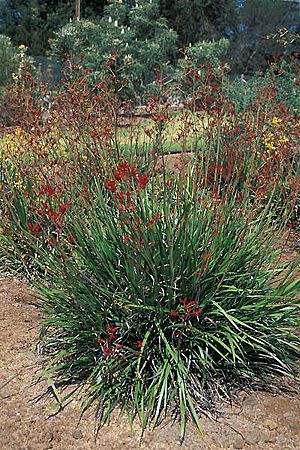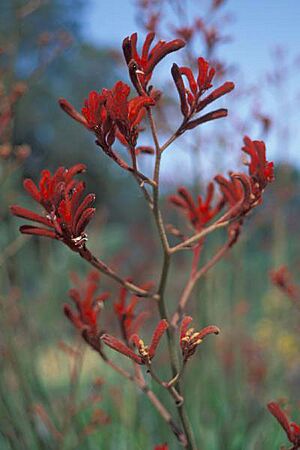Anigozanthos facts for kids
Quick facts for kids Anigozanthos |
|
|---|---|
 |
|
| Tall kangaroo paw (Anigozanthos flavidus) | |
| Scientific classification |
|
| Kingdom: | Plantae |
| Clade: | Tracheophytes |
| Clade: | Angiosperms |
| Clade: | Monocots |
| Clade: | Commelinids |
| Order: | Commelinales |
| Family: | Haemodoraceae |
| Subfamily: | Conostylidoideae |
| Genus: | Anigozanthos Labill. |
| Species | |
|
Family has about 11 species, and several subspecies are known. |
|
Anigozanthos is a group of plants from Australia. They are often called kangaroo paw or catspaw because of how their flowers look. There are 11 different types, or species, of Anigozanthos, plus several subspecies (which are like variations within a species). These plants belong to a family called Haemodoraceae.
One plant, once known as the black kangaroo paw, is now in its own group called Macropidia fuliginosa.
A French botanist named Jacques Labillardière first described the Anigozanthos group in 1800. He found the first type, Anigozanthos rufus, during an expedition to Southwest Australia in 1792. Today, many new types of kangaroo paws have been created by mixing different species. These plants are very popular for homes and as cut flowers.
The red-and-green kangaroo paw is a special symbol for Western Australia.
Contents
What Are Kangaroo Paws Like?
Kangaroo paws are perennial plants, meaning they live for more than two years. They naturally grow in dry, sandy areas of southwest Australia. However, you can find them in many other places and soil types too. People grow them to sell in Australia, the United States, Japan, and Israel.
These plants grow from short, underground stems called rhizomes. These rhizomes can be different lengths and textures depending on the species. The special liquid, or sap, in their roots helps them survive very dry times. Some types of kangaroo paws even die back to their rhizomes in summer, then grow back in autumn.
Kangaroo paws have a group of long, green to grayish-green leaves at their base. This group of leaves is called a rosette. Some species have hairy leaves. From the center of this rosette, tall, leafless stalks grow upwards. These stalks can reach up to 2 meters (about 6.5 feet) high. At the top of each stalk, there's a cluster of flowers. The size and height of these stalks, which can also be covered in colored hairs, vary among the different species.
The flower buds look like small tubes and are covered with soft, colored hairs, making them feel velvety. These furry hairs also give the flowers their color, which can be almost black, yellow, orange, or red. Some species, like Anigozanthos manglesii, even have two colors. The tube shape of the flower bud looks like a kangaroo's paw, which is how the plant got its name. The tip of the flower spreads out like a fan into six petals. A fully grown plant can have up to ten flowers on each stalk.
Types of Kangaroo Paws
There are 11 main types of Anigozanthos species. Some of these species also have subspecies, which are like unique variations. Here are some of them:
- Anigozanthos bicolor (little kangaroo paw)
- Anigozanthos bicolor ssp. bicolor
- Anigozanthos bicolor ssp. decrescens
- Anigozanthos bicolor ssp. exstans
- Anigozanthos bicolor ssp. minor
- Anigozanthos flavidus (tall kangaroo paw)
- Anigozanthos gabrielae (dwarf kangaroo paw)
- Anigozanthos humilis (cat's paw)
- Anigozanthos humilis ssp. chrysanthus
- Anigozanthos humilis ssp. grandis
- Anigozanthos kalbarriensis (Kalbarri cat's paw)
- Anigozanthos manglesii (red-and-green kangaroo paw)
- Anigozanthos manglesii ssp. manglesii
- Anigozanthos manglesii ssp. quadrans
- Anigozanthos onycis (branched cat's paw)
- Anigozanthos preissii (Albany cat's paw)
- Anigozanthos pulcherrimus (golden kangaroo paw)
- Anigozanthos rufus (red kangaroo paw)
- Anigozanthos viridis (green kangaroo paw)
- Anigozanthos viridis subsp. terraspectans
- Anigozanthos viridis subsp. metallica
New Types Grown by People
Because Anigozanthos plants are so popular for gardens and as cut flowers, many new types have been created. These new types are called cultivars. The Australian Cultivar Registration Authority has listed many of these new varieties. There are also many patents for these special plants, which means people have legal rights to grow and sell them.
Some examples of these special types include:
- Anigozanthos ‘Amber Velvet’
- Anigozanthos ‘Baby Roo’
- Anigozanthos ‘Big Red’
- Anigozanthos ‘Bush Pearl’
- Anigozanthos ‘Dwarf Delight’
- Anigozanthos ‘Gold Velvet’
- Anigozanthos ‘Kings Park Federation Flame’
- Anigozanthos ‘Mini Red’
- Anigozanthos ‘Pink Joey’
- Anigozanthos ‘Regal Claw’
- Anigozanthos ‘Ruby Jools’
- Anigozanthos ‘Space Age’
Gallery
-
Anigozanthos Bush Pearl in the Royal Botanic Gardens, Cranbourne
See also
 In Spanish: Anigozanthos para niños
In Spanish: Anigozanthos para niños






